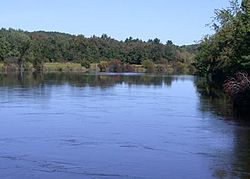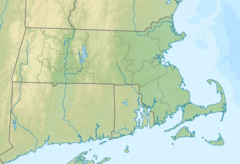| Nashua River | |
|---|---|
 Nashua River, just outside Groton, Massachusetts | |
| Location | |
| Country | United States |
| States | Massachusetts, New Hampshire |
| Counties | Middlesex, MA Hillsborough, NH |
| Towns and cities | Lancaster, Shirley, Ayer, Groton, Pepperell (MA), Hollis, Nashua (NH) |
| Physical characteristics | |
| Source | Confluence of North Nashua River and South Nashua River |
| • location | Lancaster, MA |
| • coordinates | 42°26′50″N 71°40′9″W / 42.44722°N 71.66917°W |
| • elevation | 233 feet (71 m) |
| Mouth | Merrimack River |
• location | Nashua, NH |
• coordinates | 42°45′58″N 71°26′49″W / 42.76611°N 71.44694°W |
• elevation | 95 feet (29 m) |
| Length | 37.5 mi (60.4 km) |
| Basin size | 108 square miles (280 km2) |
| Discharge | |
| • average | 150 cu ft/s (4.2 m3/s) |
| Basin features | |
| Tributaries | |
| • left | Squannacook River, Nissitissit River |
| • right | Still River |
| Type | Scenic |
| Designated | March 12, 2019[1] |
The Nashua River, 37.5 miles (60.4 km) long,[2] is a tributary of the Merrimack River in Massachusetts and New Hampshire in the United States. It is formed in eastern Worcester County, Massachusetts, at the confluence of the North Nashua River and South Nashua River, and flows generally north-northeast past Groton to join the Merrimack at Nashua, New Hampshire. The Nashua River watershed occupies a major portion of north-central Massachusetts and a much smaller portion of southern New Hampshire.
The North Nashua River rises west of Fitchburg and Westminster. It flows about 30 miles (48 km) generally southeast past Fitchburg, and joins the South Nashua River,[3] shown on USGS topographic maps as the main stem of the Nashua River,[4] about 5 miles (8 km) below its issuance from the Wachusett Reservoir.
- ^ "Explore Designated Rivers". Rivers.gov. Retrieved January 8, 2022.
- ^ U.S. Geological Survey. National Hydrography Dataset high-resolution flowline data. The National Map, accessed October 3, 2011
- ^ "Nashua River, Massachusetts & New Hampshire". National Wild and Scenic Rivers System. Retrieved December 29, 2020.
- ^ "Nashua River". Geographic Names Information System. United States Geological Survey, United States Department of the Interior.


